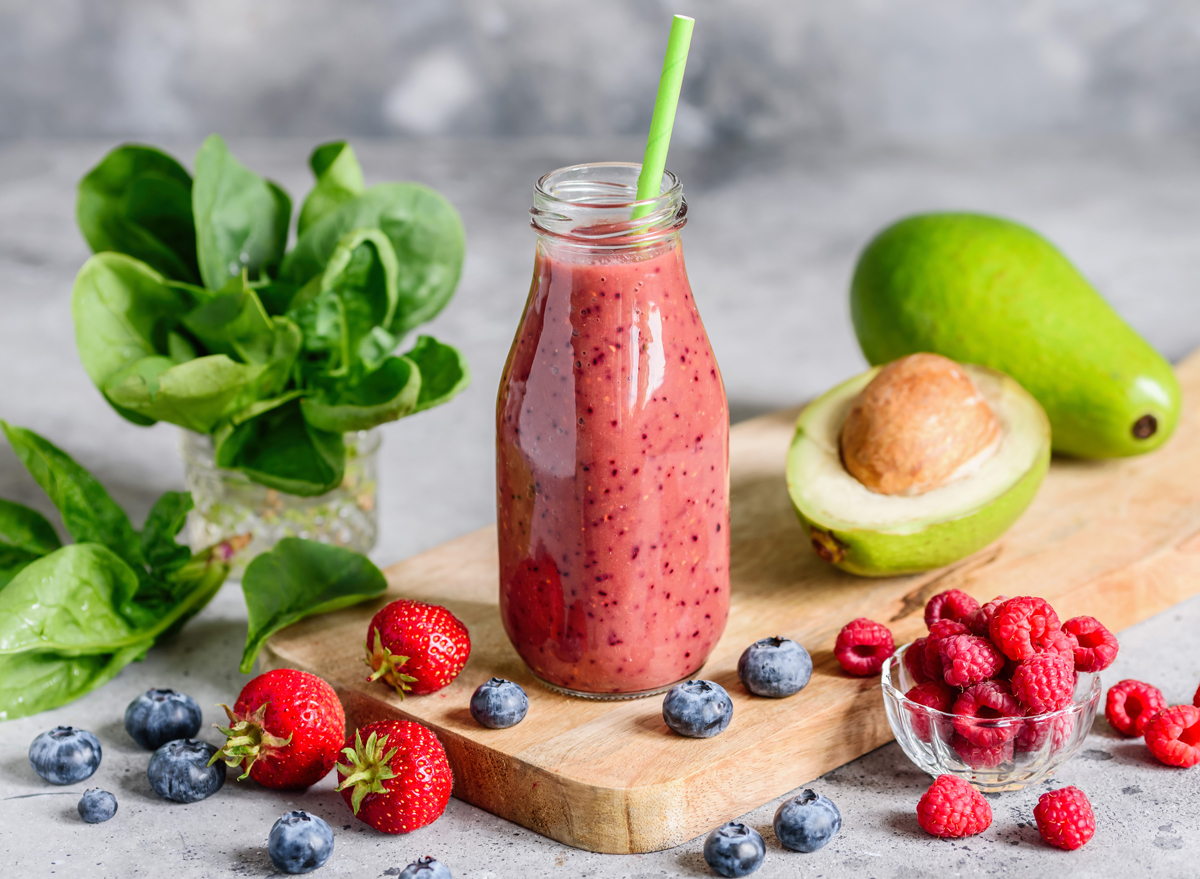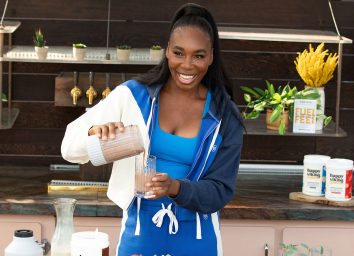The #1 Best Smoothie to Drink, Says Dietitian

Sipping on a smoothie is one of the best ways to sneak in some good-for-you nutrients without having to sit down for a full meal. For busy folks who are on the go, sipping on a blended concoction of fruits, veggies, and other goodies can help keep energy levels up and the hunger pangs at bay.
But while certain smoothies can be an excellent addition to an overall healthy diet, others can be a total sugar bomb and they can actually work against your health goals, depending on the ingredients that you include. Sure, adding real fruit, 100% fruit juice, and natural sweeteners like honey and 100% pure maple syrup to your smoothie recipe can give your body a boost of vitamins, minerals, and antioxidants. But if these are the only ingredients you use, and you don’t include other digestion-slowing macronutrients, sipping on a smoothie can result in a blood sugar spike and a subsequent crash shortly after you enjoy it.
For that reason, the #1 best smoothie you can drink is one that includes a balance of certain food categories to give your concoction nutrients and some staying power. That means your smoothie needs to have a source of protein and fiber in addition to your usual fruit and veggies. Additionally, the best smoothie should leave out liquids high in sugar as well as high-calorie sweeteners.
Read on for a breakdown of what is included in the best smoothie recipes, and for more on how to eat healthy, don’t miss 7 Healthiest Foods to Eat Right Now.
Protein

Proteins are the building blocks of life and eating enough of this macronutrient is incredibly important for the proper functioning of your body. Eating protein along with carbs, specifically, has been linked to helping people stay fuller for a longer period of time, possibly helping support weight management goals.
Many people lean on protein powders to add a boost of protein to their smoothies. But whole foods like plain Greek yogurt, nut butter, and even garbanzo beans also make excellent additions to your smoothie.
READ ON: 24 Ways To Add Protein To Your Smoothie Without Powder
Fiber

Along with protein, fiber can help promote satiety as well. Fiber can give a smoothie some bulk and can therefore help support healthy bowel movements too.
When making your smoothie, try and keep the skin on fruits like pears, apples, and peaches whenever possible. And for a sneaky add-in, including some frozen cauliflower florets can help up the fiber content of your smoothie without affecting the taste. Sliced avocado can add some unexpected creaminess to smoothies, and a handful of walnuts adds a nice flavor along with some natural fiber.
Produce

Many people lean on bananas when creating a smoothie, and for good reason. Bananas add a satisfying texture to smoothies and offer a mild taste that blends well with many food combos. As long as you are adding appropriate portions (AKA not packing two bananas into a one-serving smoothie), using this fruit is an excellent choice.
Other fruits like berries can add a sweet taste to the smoothie without the need for added sugars. During off-seasons, frozen choices can be used, and oftentimes are just as nutritious as fresh options.
And veggies like spinach, cauliflower, and even sweet potato can give smoothies a veggie boost in a super-yummy way.
Fruits and veggies can give smoothies key vitamins, minerals, and antioxidants when they are added to the blend. Just keep in mind that while the sugars found in fruit are the natural variety, the body still recognizes it as sugar, and as such, proper portion sizes should be observed.
Liquid

To make your smoothie drinkable, a liquid needs to be added. And while water would work just fine, using this liquid option doesn’t add any additional taste that your recipe may need.
When choosing a liquid, it is important to opt for choices that contain no added sugars. Coconut water, maple water, 100% fruit juice (with no sugar added), and even milk or milk alternatives can be good-for-you options that can complement the flavors already in the mixture.
READ MORE: Milk Alternatives 101: Your Guide To Every Dairy-Free Milk Substitute
Sweeteners

Smoothies are oftentimes served sweet. But additions that enhance the sweetness like agave syrup, pure maple syrup, and honey add calories and sugar to the recipe and should be included in moderation, if at all. Non-nutritive sweeteners like stevia and allulose can be included for a bit of flavor without the added calories if desired.
Alternatively, enjoy the natural sweetness that your other whole food ingredients included in your smoothie provides and skip the added sweetener altogether.
Add-Ins

While this category isn’t a must-have when making your “best” smoothie, adding ingredients like flax seeds, chia seeds, or hemp seeds can give your drink some important healthy fats, antioxidants, and minerals that you may not otherwise get in your diet. Sprinkling these add-ins into the mix before you hit the blend button is something that is simple to do and often doesn’t affect the taste of the smoothie at all.
The Formula For The ‘Best’ Smoothie

Not all smoothies are created equal. Simply tossing a bunch of fruit and juice in a blender may be tasty, but sipping it will load your body up with possibly too much sugar without any other macros to balance it out, and may ultimately leave you feeling sluggish and hungry shortly after you enjoy.
Making a point to include all of the important components of a good-for-you smoothie: protein, fiber, produce, no sugar added liquids, and possibly mix-ins, can help you enjoy your smoothie and feel good knowing that you are fueling your body with what it needs to make it through the day.
And for more, check out these 108 most popular sodas ranked by how toxic they are.
Read this next:








